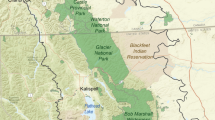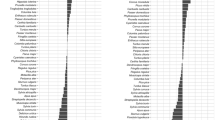Abstract
We sought to understand how the separation of habitats into spatially isolated fragments influences the abundance of organisms. Using a simple, deterministic model of population growth, we compared analytically exact solutions predicting abundance of consumers in two isolated patches with abundance of consumers in a single large patch where the carrying capacity of the large patch is the sum of the carrying capacities of the isolated ones. For the deterministic model, the effect of fragmentation was to slow the rate of population growth in the fragmented habitat relative to the intact one. We also analyzed a stochastic version of the model to examine the effect of fragmentation on population abundance when resources vary randomly in time. For the stochastic model, the effect of fragmentation was to reduce population abundance. We proved in closed-form, that for a non-equilibrium population exhibiting logistic population growth, fragmentation will reduce population size even when the total carrying capacity is not affected by fragmentation. We provide a theoretical basis for the prediction that habitat fragmentation amplifies the effect of habitat loss on the abundance of mobile organisms.


Similar content being viewed by others
References
Blackburn HB, Hobbs NT, Detling JK (2010) Nonlinear responses to food availability shape effects of habitat fragmentation on consumers. Ecology (in press)
Connor E, Courtney A, Yoder J (2000) Individuals–area relationships: the relationship between animal population density and area. Ecology 81:734–748
Debinski D, Holt R (2000) A survey and overview of habitat fragmentation experiments. Conserv Biol 14:342–355
Ellis J, Swift D (1998) Stability of African pastoral ecosystems: alternate paradigms and implications for development. J Range Manag 41:450–459
Ewers R, Didham R (2006) Confounding factors in the detection of species responses to habitat fragmentation. Biol Rev 81:117–142
Fahrig L (2003) Effects of habitat fragmentation on biodiversity. Annu Rev Ecol Evol S 34:487–515
Fischer J, Lindenmayer D (2007) Landscape modification and habitat fragmentation: a synthesis. Glob Ecol Biogeogr 16:265–280
Fletcher R, Ries L, Battin J, Chalfoun A (2007) The role of habitat area and edge in fragmented landscapes: definitively distinct or inevitably intertwined? Can J Zool 85:1017–1030
Freedman H, Waltman P (1977) Mathematical models of population interactions with dispersal. I: stability of two habitats with and without a predator. SIAM J Appl Math 32:631–648
Galvin KA, Reid RS, Behnke RH, Hobbs NT (2008) Fragmentation in semi-arid and arid landscapes: consequences for human and natural systems. Springer, Dordrecht, The Netherlands
Gaston K, Matter S (2002) Individuals–area relationships: comment. Ecology 83:288–293
Haila Y (2002) A conceptual genealogy of fragmentation research: from island biogeography to landscape ecology. Ecol Appl 12:321–334
Harrison S, Bruna E (1999) Individuals–area relationships: comment. Ecography 22:225–232
Hayward M, Kerley G (2009) Fencing for conservation: restriction of evolutionary potential or a riposte to threatening processes? Biol Conserv 142:1–13
Hobbs NT, Galvin K, Stokes CJ, Lackett JM, Ash AJ, Boone RB, Reid RS, Thornton PK (2008) Fragmentation of rangelands: implications for humans, animals, and landscapes. Glob Environ Change 18:776–785
Holt R (1985) Population dynamics in two-patch environments: some anomalous consequences of an optimal habitat distribution. Theor Popul Biol 28:181–208
McGarigal K, Cushman S (2002) Comparative evaluation of experimental approaches to the study of habitat fragmentation effects. Ecol Appl 12:335–345
Pimm S, Raven P (2000) Extinction by numbers. Nature 403:843–845
Pimm S, Raven P, Peterson A, Sekercioglu C, Ehrlich P (2006) Human impacts on the rates of recent, present, and future bird extinctions. P Natl Acad Sci 103:10941–10946
Pimm S, Russell G, Gittleman J, Brooks T (1995) The future of biodiversity. Science 269:347–350
Searle KR, Hobbs NT, Jaronski SR (2010) Asynchrony, fragmentation, and scale determine benefits of landscape heterogeneity to mobile herbivores. Oecologia 163:815–824
Sibly R, Barker D, Denham M, Hone J, Pagel M (2005) On the regulation of populations of mammals, birds, fish, and insects. Science 309:607–610
Smith O (2010) Dynamics of large herbivore populations in changing environments: toward appropriate models. Wiley-Blackwell, Hoboken, NJ
Soulé M, Orians G (2001) Conservation biology: research priorities for the next decade. Island Press, Washington, DC
Stutchbury B (2007) The effects of habitat fragmentation on animals: gaps in our knowledge and new approaches. Can J Zool 85:1015–1016
Trombulak S, Frissell C (2000) Review of ecological effects of roads on terrestrial and aquatic communities. Conserv Biol 14:18–30
Tscharntke T, Brandl R (2004) Plant–insect interactions in fragmented landscapes. Annu Rev Entomol 49:405–430
Underwood N (2004) Variance and skew of the distribution of plant quality influence herbivore population dynamics. Ecology 85:686–693
Wiens J (1977) On competition and variable environments. Am Sci 65:590597
Acknowledgements
Support for this work was provided by the National Science Foundation Grant: “Effects of Habitat Fragmentation on Consumer Resource Dynamics in Environments Varying in Space and Time”, Grant No. DEB0444711, and by NSF-IGERT Grant DGE-#0221595 administered by the PRIMES program at Colorado State University. We thank K. Searle and two anonymous reviewers for helpful comments on the manuscript. The work reported here was supported in part by the National Science Foundation while Hobbs was serving as a rotating Program Director in the Division of Environmental Biology. Any opinions, findings, conclusions, or recommendations are those of the authors and do not necessarily reflect the views of the National Science Foundation.
Author information
Authors and Affiliations
Corresponding author
Rights and permissions
About this article
Cite this article
Herbener, K.W., Tavener, S.J. & Hobbs, N.T. The distinct effects of habitat fragmentation on population size. Theor Ecol 5, 73–82 (2012). https://doi.org/10.1007/s12080-010-0097-6
Received:
Accepted:
Published:
Issue Date:
DOI: https://doi.org/10.1007/s12080-010-0097-6




